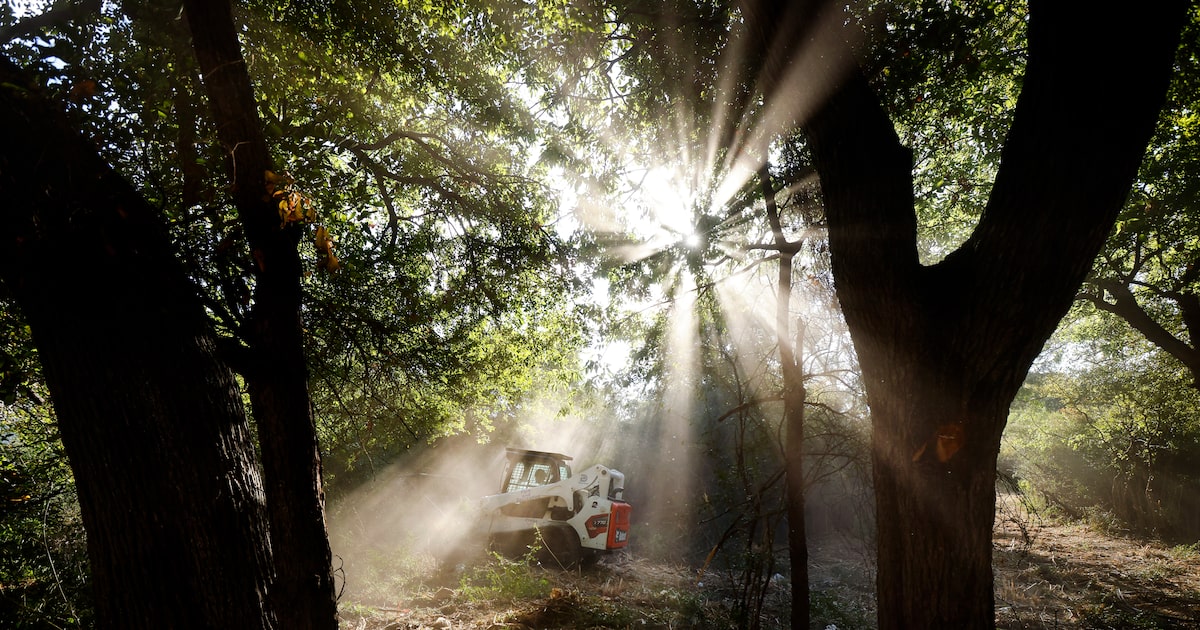Projected declines in sales and property tax collections, plus increases in police and firefighter budgets, have dictated that the Dallas Park and Recreation Department cut $3 million from its 2025-26 budget. Community pool closures and recreation center cutbacks made headlines, but Park Department duties extend well beyond leisure activities.
Privet
Outside of downtown, encampments of unhoused are primarily in parks, greenbelts and the Great Trinity Forest — almost always in places infested with privet, an invasive evergreen shrub whose rapid, thick growth screens encampments from view. Yet the department may have to suspend invasive species management to account for the $3 million cut.
According to Ryan Moore, president of Friends of Bachman Lake, which deals with 20 acres of privet and encampments in the Bachman Creek Greenbelt, “Each major clearing project has improved visibility and made the greenbelt safer and more welcoming for an increasing number of walkers, runners, and families.”
On newly cleared land, native wildflowers flourish which support bees, butterflies and other pollinators, Moore said.
Opinion
Privet management is a primary way the Park Department engages volunteers. Teams of hard workers cut down small to medium privet with loppers. Then park crews follow up with treatment to prevent the plant from regrowing and creating even denser stands.
One success story is the Ned and Genie Fritz Texas Buckeye Trail. Not long ago, the dirt trails to the Texas buckeyes had become nearly impossible to traverse due to privet. The ivory blooms, which have inspired annual walks since the 1980s, were barely visible. Now thanks to hundreds of motivated volunteers marshaled by the Park Department, trails are open and blooms are viewable.
Ash borers
Emerald ash borer larvae burrow beneath ash tree bark. A devastating pest in many U.S. regions, borers have killed tens of millions of ash trees. Some arborists predict it will destroy most of North America’s nearly 9 billion ash trees.
Borers are found in Dallas and most surrounding counties. Texas Trees Foundation estimates that about 2 million trees, or 13% of all Dallas trees, are ash. At least 23% of the Great Trinity Forest is ash, including some large concentrations. This crisis falls squarely within the Park Department purview.
Devastation is coming, and it will be huge. Tree death occurs within three years of infestation, leaving a large standing pile of flammable tinder. Reduction of the parks budget will impact management of ash trees, which is already behind the curve. Dead flammable trees combined with campfires in homeless encampments are the ingredients of impending disaster.
Dallas trees must be surveyed. Mature ash trees that dominate parks and public spaces must be treated with insecticide, which must be done regularly until the infestation is controlled. Others must be monitored and managed.
Borer maintenance costs money. Slacking on these efforts could allow infestations to intensify faster than arborists can respond, devastating property and leaving public spaces with an increased fire danger.
Developer fees
In the face of all this comes the irresponsible proposal by the City Plan Commission to cut by 50% the parkland dedication fees paid by housing developers.
House Bill 1526, passed in 2023, similarly limits parkland dedication ordinances.
Even with these new state rules, parkland fees could bring in as much as $1,300 per dwelling unit, according to Rudy Karimi, District 14 Dallas Park Board member. The upcoming Pepper Square development in North Dallas, Karimi said, “If fully aligned with HB 1526, could bring in $1,021,000, a significant boost for parkland funding.”
Parks are our future. In studies conducted by The Nature Conservancy and the Trust for Public Land, people express a strong desire for more healthy parks and green spaces, which in turn increase surrounding property values and tax revenue. Dallas has made significant progress in the last 10 years. Losing this momentum by slashing park funding would have negative ramifications for decades to come.
Amy Martin is the author of “Wild DFW: Explore the Amazing Nature Around Dallas-Fort Worth” and sits on Dallas County Open Space’s Trails and Preserves Program board.

